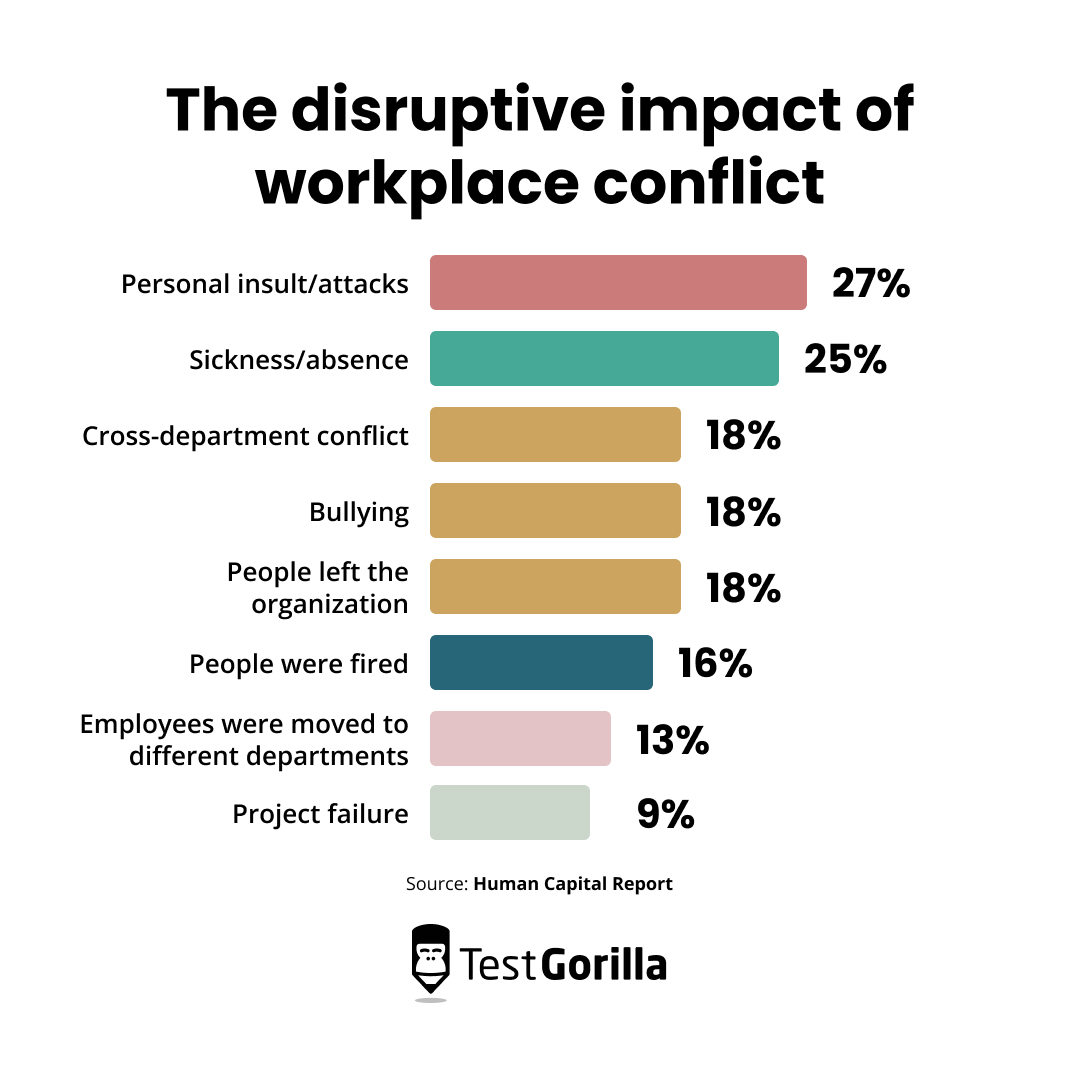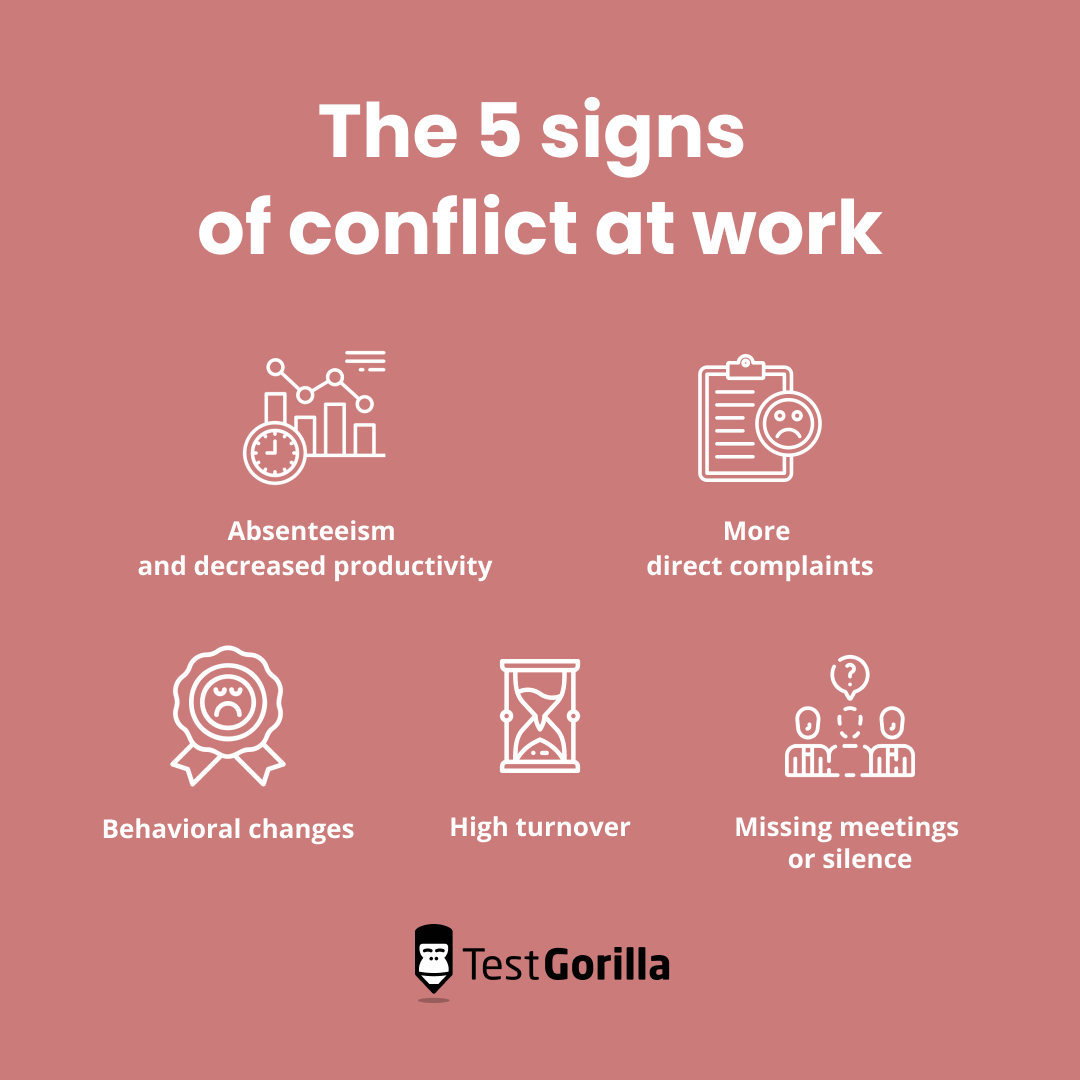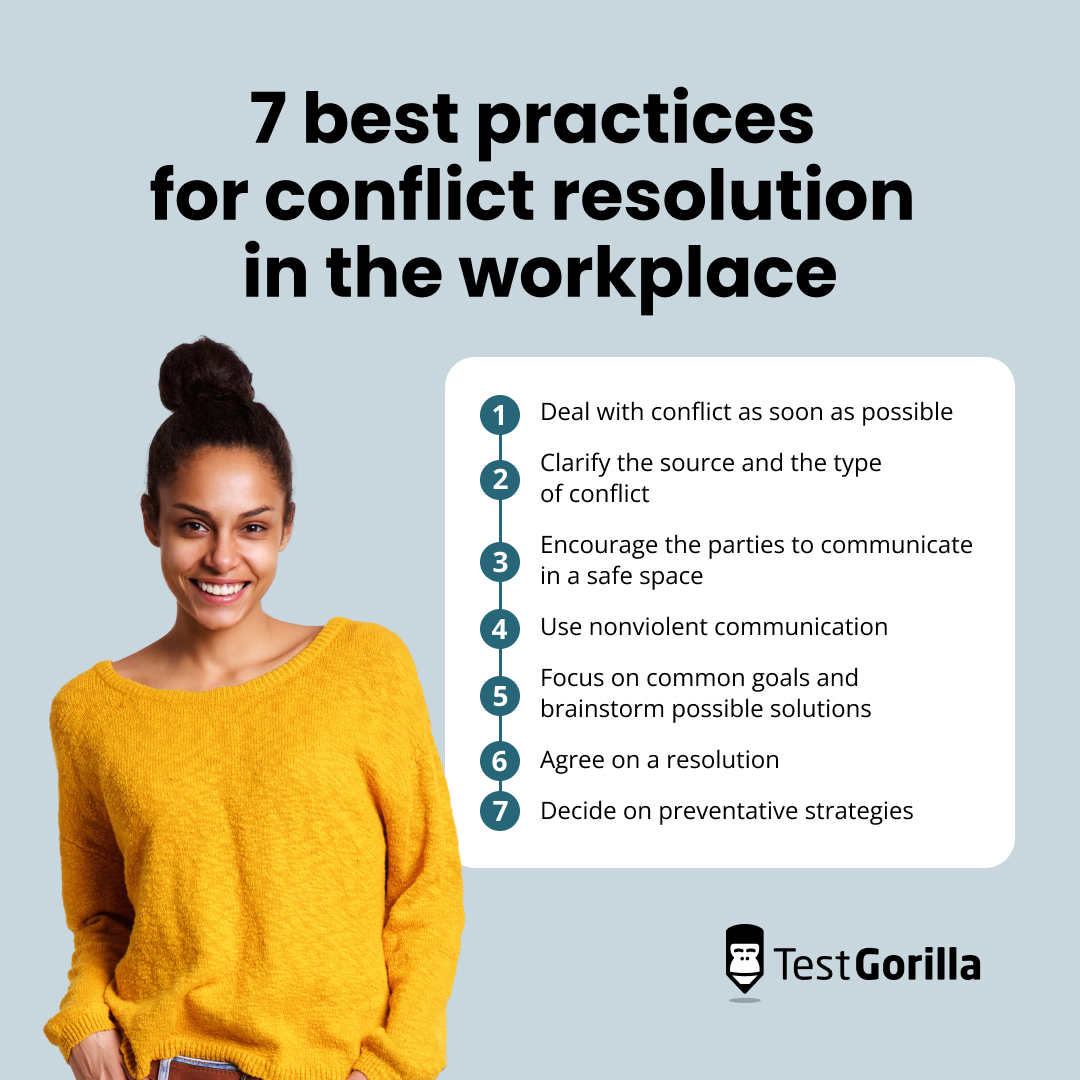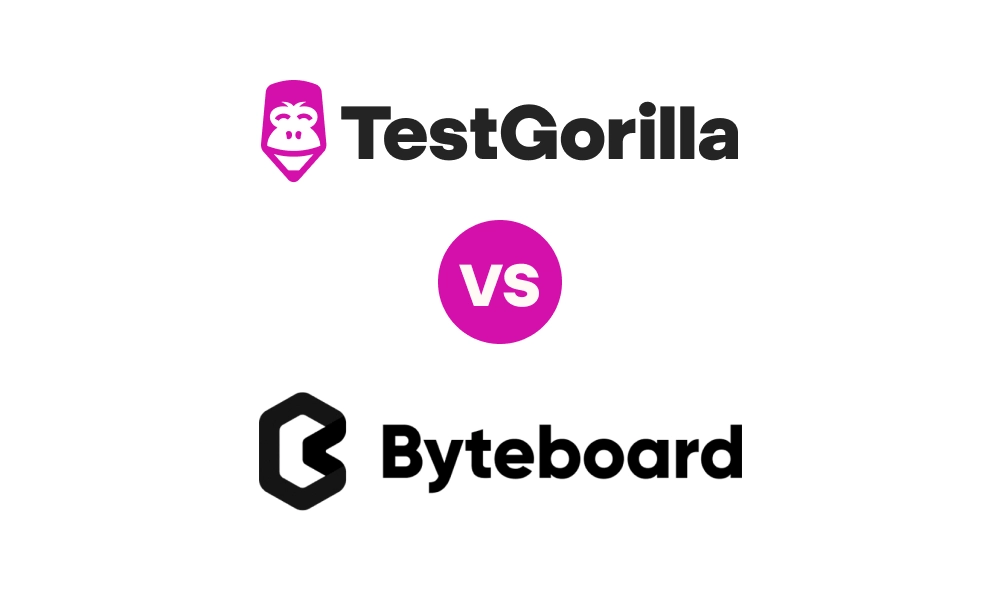Handling workplace conflict is one of the toughest parts of being a human resources professional.
Every job has difficult tasks, but mediating disputes to resolve conflict is stressful, hectic, and loaded with emotions.
It's more than just a "tricky situation" – conflict at work can trickle down your entire company, fostering resentment and toxic company culture, which, in turn, is the largest driver of attrition, ranking 10.4 times higher than compensation issues.[1]
Handling employee conflict is, therefore, an essential skill, and every HR team should have a handbook of go-to strategies to deal with it.
This blog post is your handbook.
We discuss how to identify and handle different types of workplace conflict, real examples of conflict resolution, and how to prevent conflict in the first place.
Table of contents
- What is workplace conflict?
- What is the impact of workplace conflict?
- The different types of conflict in the workplace
- How to identify workplace conflict: The 5 signs of conflict at work
- How to handle workplace conflict: 7 best practices for conflict resolution in the workplace
- 3 examples of workplace conflict resolution
- How to prevent workplace conflict: 4 ideas to try
- Reduce workplace conflict by building an inclusive skills-based culture
What is workplace conflict?
Workplace conflict is the actual or perceived dispute between two or more people in an organization. It’s often a conflict of needs, values, beliefs, or interests.
There are many types of workplace conflict, and they’re all damaging to your organization to some degree, whether it’s through resentment, absenteeism, or behavioral changes.
Let’s quickly clarify the difference between conflict and healthy disagreements: Disagreements are a normal part of working relationships and aren’t necessarily bad.
For example, if a designer and a developer disagree about how to implement a new feature on a website, the resulting compromise could produce a better outcome for the whole team because the debate ensures that the new feature meets all of the requirements.
In fact, Harvard experts have advocated for disagreeing more at work exactly for this reason. Healthy disagreements are a necessary step in the problem-solving process.[2]
Solutions would be stuck on flimsy first drafts if your employees and managers were nothing but yes-men.
Real conflict at work is any dispute that disrupts the flow of work. If a conflict gets ugly or personal, stops team members from doing their jobs, or negatively affects the work environment, that’s when you need to step in.
What is the impact of workplace conflict?
Learning how to deal with workplace conflict doesn’t just prevent raised voices. Real workplace conflict can expand into an unhealthy, toxic culture.
The full impact of workplace conflict can include:
Personal attacks and insults
Absence and sick days
Conflict between departments
Bullying
Employees resigning
Colleagues being fired
Team members being moved between departments
The failure of projects
This is distinct from a healthy, challenging environment.
A key element in a culture with healthy disagreements is fostering psychological safety. Psychological safety is when employees feel safe and comfortable making suggestions, making mistakes, and asking questions.
We talk more about the importance of safe culture later in this blog.
The different types of conflict in the workplace
Resolving conflict in the workplace is easier when you know where it came from.
Not all disputes are the same, and knowing the different types of workplace conflict not only helps you handle conflict but also prevents it.
Personality
We’ve all worked with someone with a different personality who rubbed us up the wrong way.
One of the more common personality workplace conflict examples is the classic introvert vs. extrovert dispute. For instance, an extrovert might feel offended that their introverted colleague doesn’t want to come to a company lunch.
Workplace conflict stories like these are a natural part of life and among the most common to occur in a workplace.
Cultural differences
Cultural differences are common, but sometimes they develop into real conflict.
Often, it’s accidental, like how German people are usually slower to build friendships, but Americans tend to immediately feel that their colleagues are their friends.
This type of cross-cultural conflict can cause hurt feelings or resentment when it’s only a miscommunication.
This can also happen to employees coming from different companies. A worker coming from a relaxed organization may use more exclamation marks or emojis in the group chat, making co-workers think they’re unprofessional.
Task-based
Task-based conflict isn’t about the people you work with, it’s about the work itself.
There are many instances when this can arise, for example:
Poor communication between interdependent teams
Disagreement about the allocation of resources
Frustration at outdated processes
Misunderstandings about delegation and deadlines
This type of conflict usually stems from an organization needing clear documentation, processes, and roles and responsibilities.
Creative
Creative conflict is when two or more workers have different viewpoints surrounding creativity and innovation.
For example, two content strategists have different ideas for a client’s content strategy. One wants to build a professional brand voice and stick to blogs and articles, the other wants to adopt a casual, slangy brand voice and prioritize social media.
Creative disagreements can often be healthy – you just need to be mindful of handling workplace conflict that could stem from it.
Personal drama
Personal drama is different from a clash of personalities. It doesn’t often involve differing opinions, and it’s usually a case of one or more employees being immature.
For example, one employee asks their colleague on a date, despite it being against company policy. They get rejected and proceed to resent their colleague in unrelated ways, letting the grudge seep into every professional interaction they have.
Working style
This type of workplace conflict is when the way that people prefer to work is incompatible.
Most people have experienced this, and it’s one of the most common causes of workplace conflict.
A great example is one employee who likes to work quietly in their own space, focusing in a private “deep work” mode. However, their co-worker prefers animated brainstorming and discussions during work.
Leadership style
Managing workplace conflict isn’t all about your employees – it happens from above, too.
Business leaders set the atmosphere for their teams, so differing leadership styles can cause conflict.
There are different leadership styles in business, and any one of them could be perfect for one stage in your company’s growth and terrible for another.
Let’s say you hire a visionary, big-picture thinker for a project management role. They’re all about the vision and not about creating a list of tasks.
Neglecting the task list would trickle down into task-based and working style conflicts among the workers it affects.
Discrimination
Discrimination-based conflict stems from judging another person on points including values, race, gender, lifestyle, and religion.
This type of conflict can be direct discrimination or related to unconscious bias.
Here are a few discrimination-based workplace conflict examples:
A warehouse worker assumes his colleague can’t lift a crate because she’s a woman, escalating into sexist comments
One employee refuses to collaborate with another after knowing their religious views and affiliations
Conflict like this can happen for two reasons, depending on whether it’s discrimination or unconscious bias:
Type of conflict | Description |
Unconscious bias | This is innate within every person, although it’s more prevalent in companies with little unconscious bias training and inclusivity. |
Discrimination | This can stem from workplaces with exclusivity and toxic atmospheres. It’s also perpetuated when toxic colleagues like asshole geniuses go around unchallenged. |
How to identify workplace conflict: The 5 signs of conflict at work
Workforce conflict resolution is easiest when you can spot it before it erupts into a dramatic disaster.
Let’s take a look at the main signs that conflict might be brewing behind the scenes.
1. Absenteeism and decreased productivity
Employees who are embroiled in conflict or simply in a company filled with conflict slow down. Their performance drops, and they may start quiet quitting.
Further, employees who feel resentful toward their workplace may not show up at all.
2. More direct complaints
Employees find things to complain about in a toxic atmosphere rife with conflict and generally carry a negative attitude around with them.
However, it’s important to note that if your organization is filled with conflict, employees may have good reasons to complain – so please don’t ignore them.
3. Behavioral changes
When organizations have unmanaged workplace conflict, employees may start developing a silo mentality, meaning that they cloister themselves into their own groups. This divides teams and limits innovation. It also breeds workplace gossip.
For example, Alex fought with Kim, so now Alex tells colleagues about how Kim is argumentative.
This not only strains trust, it also forms cliques. For example, Alex and their group go out to lunch together. They not only don’t invite Kim, they don’t invite anyone who’s nice to Kim.
4. High turnover
Workplace conflict decreases trust and causes employee burnout, and when they can’t take it anymore, they walk out the door.
As we mentioned at the beginning of this article, a toxic culture is the greatest driver of attrition.
Conflict at work perpetuates the cycle of churn and burn the longer it goes unchecked.
5. Missing meetings or silence
Some employees may stop attending meetings or answering group messages.
This could be an angry employee who simply doesn’t want to engage, but it could also be an employee who feels devalued because of workplace trauma and feels like their coworkers don’t want them around.
How to handle workplace conflict: 7 best practices for conflict resolution in the workplace
We know workplace conflict has a detrimental impact, so let’s learn about the best resolution process to properly address it.
We recommend moving the affected employees to a private area, using nonviolent effective communication, and working to come to an agreeable resolution.
Here are our top workplace conflict resolution strategies for creating positive change.
1. Deal with conflict as soon as possible
Address conflict as soon as it rears its head. Don’t put it off for a rainy day and let the situation grow out of hand.
Here are a few tips:
Ask affected employees if they want to talk: If you see a few workers who look to be at odds, check in on them. Do this as soon as possible, but try to be delicate about it.
Ask employees about possible conflicts during one-on-one meetings: One-on-one meetings shouldn’t just be about work tasks. Try asking if anything’s bothering them and how their mental health is.
Offer to play the mediator: If you’re right and conflict is brewing, ask if they’d like your help and offer to mediate the discussion. Acting as a calm negotiator before things get out of hand is one of the best ways of dealing with workplace conflict.
These might seem like obvious points, but one of the main reasons that toxic cultures spread is that people ignore conflict in hopes that it will vanish on its own.
2. Clarify the source and the type of conflict
You can’t solve a problem if you don’t know what caused it.
For example, Mala works differently than her colleagues. She prefers to use her flexible schedule to get the bulk of her tasks done late at night, but this causes her colleagues to think she’s avoiding them.
This could be a working style conflict, a task-based conflict, or even a personality-based conflict. But once Mala’s HR manager gets to the bottom of it, it’s actually a cultural conflict because it’s how most of her colleagues worked at her former job.
Understanding which of the types of workplace conflict you’re dealing with helps you resolve it more easily, efficiently, and delicately.
3. Encourage the parties to communicate in a safe space
Communication skills are essential to resolving disputes, but they don’t help if you’re communicating in the middle of a noisy office. Or in front of other employees who inserted themselves into the situation, even if they did it with good intentions.
Conflict at work can snowball into something bigger than it is when employees feel threatened or misrepresented, which happens easily when they have an audience.
Bring conflicting parties to a safe space and encourage them to talk with a third party mediator.
In person, this might look like taking everyone involved into an unused office or conference room. Virtually, you could open a Slack channel just for the employees involved in the conflict and the mediator.
This ensures that everyone stays focused, no one gets antagonized by outside sources, and everyone feels safe and secluded.
4. Use nonviolent communication
Nonviolent communication is a great tool to help discuss the conflict and encourage employees to speak respectfully.
How does it work?
In a discussion using nonviolent communication, there are two modes that each participant needs to be in at all times:
Clearly expressing themselves without assigning blame or criticism
Empathically listening to others without assuming blame or criticism
Essentially, it’s calmly expressing yourself and using active listening. This throws out “coercive language” – any language that is designed to make someone feel afraid, guilty, or ashamed.
Here are a few examples of coercive language:
“He’s always doing that! You know everybody hates that.”
“She’s trying to make me feel bad.”
“This is all their fault. I didn’t do anything.”
This communication, also called “violent communication,” makes assumptions about other people, casts blame, and tells them what their own experience is.
When you encourage nonviolent communication, you clear away distractions so that all parties can focus on clarifying the deeper causes of the conflict.
5. Focus on common goals and brainstorm possible solutions
Focusing on common goals is one of the best ways to nurture inclusivity and promote a healthy company culture.
Encourage people to submit possible solutions and offer some up yourself. Hold a brainstorming session where everyone submits ideas.
Ask every party to consider healthy ways to find a middle ground. Does everyone present want the project done next Friday? Great. Can everyone agree that they want the landing page to have an animation? Excellent, let’s go from there.
We might disagree and have different points of view, but at the end of the day, we all want to complete our work.
6. Agree on a resolution
Once you find your common ground, and it leads to an acceptable solution, ensure you get everyone present to agree to it. This solution may lean towards one person’s side of the argument, or it might not – simply focus on finding the best response to the issue.
It’s natural that not everyone will be 100% satisfied with the solution, but they can still be open to it.
When agreeing to a solution, it’s important to remember to encourage humility in each party.
Even if someone is clearly “wrong” in the conflict, it helps the situation to have the person who’s “right” put in the effort to reach an agreement, even if they did nothing wrong. This demonstrates good faith to the employee who’s “wrong” and helps prevent them from feeling victimized.
This is also a good time to determine if each party can do anything to prevent this conflict in the future.
And that leads us to our next point.
7. Decide on preventative strategies
We admit it’s a bit corny, but the best solution to a problem is preventing it.
After a conflict, take some time to talk with your people and determine what can prevent this from happening in the future.
Or better yet, build strategies to prevent workplace conflict before it happens. Assess your workplace and determine what would prevent disputes in the best way for your organization.
Try asking your people and seek their opinions. It’s always a good idea to learn from past conflicts – they provide valuable, specific insights.
If you’d like to get right to it, feel free to skip ahead to our strategies for preventing workplace conflict.
3 examples of workplace conflict resolution
Let’s take a look at a few tangible workplace conflict examples.
In each of the three examples, we describe the scenario, examine the type of conflict at play, and discuss the strategies we can use to resolve it.
Task-based conflict
Each Wednesday, Jonathan is meant to send Nicky, his colleague, data for a report. However, he has been late in doing so for several weeks.
Nicky needs to present the report in her Thursday morning meeting with senior executives, forcing her to stay late on Wednesdays to finish her report.
Communications between Jonathan and Nicky have turned sour, and Nicky has been refusing to help Jonathan when he needs something from her, even if it’s unrelated to the report.
This is an example of a task-based conflict. Resentment is growing because Jonathan isn’t collecting the data he said he would.
How do you resolve this situation? We’d recommend nonviolent communication, a safe space to talk, and focusing on common goals to agree on a solution.
Here’s an example of nonviolent communication from Nicky’s point of view:
“I’m frustrated because I don’t get the data for the report on time. Would you be able to explain the delays in getting the data to me for the past few weeks?”
This is healthy communication because it expresses her experience without assuming anything about Jonathan.
Jonathan could then explain what’s been preventing him from meeting the deadline and propose a solution, such as moving the weekly meetings that take up his time on Wednesdays or making the report a shared document he and Nicky can collaborate on.
Discrimination-based conflict
Real-life examples of workplace conflict don’t always end well, but this one makes you proud of the HR manager involved.
This Reddit user describes how they mediated a conflict between two employees over a homophobic remark.
These two workers got into a messy dispute over the comment. The HR manager says it’s clear that it was a simple misunderstanding, but neither party would listen.
This falling out caused both employees to stop communicating, and it eventually delayed the project they were working on.
How did the manager handle it? They describe their process:
“I usually speak to both parties separately first so that I can assess the situation. If possible, I also consult with a senior team member for an objective 3rd party opinion of what actually happened and the impact on the working environment.”
They say that their main tactic is sitting with each employee, asking them for their ideal solution, and then working from there.
To prevent this type of conflict, read our blog on LGBTQ+ inclusion in the workplace.
Leadership style conflict
Sean and Kevin are both managers at the same company.
Sean believes that work should be fast-paced and effort-driven. He prioritizes long hours, a competitive atmosphere, and a hustle culture.
Kevin is quite the opposite: He prefers flexible work and doesn’t care if you don’t put in the hours as long as you get your tasks done.
One day, Kevin hires a disabled employee named Jordan, who needs accommodations like flexible work, shorter hours, and a strong work-life balance.
This creates a conflict where Sean thinks Jordan is a slacker, and Jordan thinks Sean is oppressive and demanding.
They resolve this issue by describing the situation in full, reasoning that some people need different types of work, and expanding Sean’s idea of what hard work is.
Over time, this organization nurtures disability inclusion in the workplace. This enables them to support different workers’ needs while still keeping their fast-paced culture for those who want it.
How to prevent workplace conflict: 4 ideas to try
It’s true that a vaccine is better than a cure.
Workplace conflict management can be done, but it’s easier and healthier to prevent it in the first place.
Here are our top strategies on how to do it.
Ways to prevent workplace conflict: A summary
Methods | Description |
1. Build an inclusive, safe company culture | Work to create a safe and accepting atmosphere where employees can be themselves |
2. Create stronger team cohesion | Build a strong, unified culture Encourage team building in remote teams and across departments |
3. Focus on “culture add” when building your team | Use culture add assessments to build a diverse company with shared values |
4. Use talent assessments to hire the right team | - Leverage talent assessments to recruit employees for their empathy - Hire people who have the right skills for their role, reducing stress and preventing conflict |
1. Build an inclusive, safe company culture
Ensure your workplace is safe and accepting for everyone. This prevents workplace conflict and makes it less destructive when it happens because people feel safe and accepted.
Here are a few tips:
Encourage feedback and constructive disagreements
Respect personal differences
Combat workplace bullying
Make your values clear to all
Prioritizing inclusiveness is key to fostering a healthy culture and preventing conflict. A lot of conflict happens because companies don’t actively support different people with different working styles and personalities.
2. Create stronger team cohesion
Actively promote team building, relationship building, and collaboration. Differences and disagreements are easier to tackle when everyone has a base level of respect.
This is especially important for remote companies and teams. It can be difficult to naturally build a cohesive culture when you aren’t in the office, and it takes a little more active effort.
This also goes for hybrid teams. Employees who aren’t at the office 100% of the time may be affected by proximity bias and could be forgotten or left out of team events.
Building strong team cohesion is also important to encourage between departments. Another department isn’t some kind of distant “competition” – they’re also your colleagues.
3. Focus on “culture add” when building your team
Culture fit is the traditional way to recruit, but it isn’t the most effective. Hiring for culture add helps build a diverse team with unique perspectives yet shared values.
Using assessments like our Culture Add test enables you to reduce culture- and personality-based conflict. But because it encourages diverse thought, it also opens the door for healthy, innovation-boosting conflict.
Keep in mind that even companies that hire for culture add can have a clash of values. Culture additions may have slightly different values than your own. The point is that you hire similar people, not identical.
4. Use talent assessments to hire the right team
Talent assessments help you hire the right people in the first place.
Traditional hiring methods do little to avert potential workplace conflicts because a resume can’t show you a candidate’s problem-solving and communication skills, which are key to productive conflict resolution.
But using skills tests can help you:
Hire employees with strong communication skills
Hire a business manager with excellent conflict resolution skills so they can spot and diffuse conflict before it becomes an issue
Hire employees that have skill sets that match their jobs, making tasks flow easier
Hire employees with key personality traits, such as empathy and conscientiousness
One of the best ways to prevent workplace conflict is to make sure that you build your company on a solid foundation, and talent assessments ensure you find the best employees to support your business.
Check out our conflict resolution interview questions for ideas on what to ask during interviews.
Reduce workplace conflict by building an inclusive skills-based culture
Conflict resolution in the workplace doesn’t have to be difficult. It might be intimidating, but with the right strategies, you can mitigate disputes and ensure everyone is satisfied with the results.
Try strategies like encouraging nonviolent communication or moving the affected employees to a safe, calm room.
Better yet, prevent workplace conflict in the first place by fostering an inclusive environment, building strong team relationships, and hiring people through talent assessments.
If you’d like more information on the type of atmosphere that leads to conflict, read our blog on workplace negativity.
To assess your next hire with skills tests, browse our test library of more than 300 assessments.
Sources
Gallo, Amy. (January 3, 2018). "Why We Should Be Disagreeing More at Work". Harvard Business Review. Retrieved August 24, 2023. https://hbr.org/2018/01/why-we-should-be-disagreeing-more-at-work
Sull, Donald; Sull, Charles; Zweig, Ben. (January 11, 2022). "Toxic Culture Is Driving the Great Resignation". MIT Sloan. Retrieved August 24, 2023. https://sloanreview.mit.edu/article/toxic-culture-is-driving-the-great-resignation/
Related posts
Hire the best candidates with TestGorilla
Create pre-employment assessments in minutes to screen candidates, save time, and hire the best talent.
Latest posts
The best advice in pre-employment testing, in your inbox.
No spam. Unsubscribe at any time.

Hire the best. No bias. No stress.
Our screening tests identify the best candidates and make your hiring decisions faster, easier, and bias-free.
Free resources
This checklist covers key features you should look for when choosing a skills testing platform
This resource will help you develop an onboarding checklist for new hires.
How to assess your candidates' attention to detail.
Learn how to get human resources certified through HRCI or SHRM.
Learn how you can improve the level of talent at your company.
Learn how CapitalT reduced hiring bias with online skills assessments.
Learn how to make the resume process more efficient and more effective.
Improve your hiring strategy with these 7 critical recruitment metrics.
Learn how Sukhi decreased time spent reviewing resumes by 83%!
Hire more efficiently with these hacks that 99% of recruiters aren't using.
Make a business case for diversity and inclusion initiatives with this data.






















